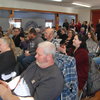lsquo What rsquo s going on rsquo More special-needs students at BKW
‘What’s going on?’
More special-needs students at BKW
BERNE On Monday, Kimberly LaBelle, Berne-Knox-Westerlo’s assistant superintendent for elementary and special education, outlined the school’s program for disabled students.
LaBelle highlighted special-education enrollment, new programs and services, and projections. When she first started in 2002, she said, 158 students were enrolled in special-education programs.
“Now,” LaBelle said, “we’ve grown to 224, so that’s quite an increase over time.”
One year ago, she reported that BKW had 45 special-needs students transfer into the district. Since July 1, the start of a school year, she said, BKW has had only 14 new students.
“All summer long, we kept saying, ‘What’s going on? We don’t have a lot of kids enrolling,’” she said.
Of the 14 students, she said, seven enrolled within the past month-and-a-half to two months. “We had a number of new kids enroll since January,” she said.
Currently, 59 students, or 12 percent of the 455 students in the elementary school, are enrolled in special education programs. Of the 232 middle-school students, 38, or 16 percent, are enrolled. And, of 384 high-schoolers, 62, or 16 percent are in special-ed. programs.
“I think there is a myth out there that the more special-ed. kids that we have, the more money it generates,” LaBelle said. All of the money it generates is through aid, she said, but the aid doesn’t cover all of the costs.
“There are still net costs that the district is responsible for,” LaBelle said.
Programs run by the Board Of Cooperative Educational Services, she said, all have different costs associated. “Our number in BOCES, I believe last year, when I did this presentation…was 27,” LaBelle said. “This year, we have 29 students who are enrolled in a variety of BOCES programs.”
Business administrator on aid
BKW’s business administrator, Timothy Holmes, outlined aid for special-education students.
“It’s very difficult to get a relationship between how many students you have and how much aid you receive,” he said.
A lot of the children, he said, fit into “high cost aid,” which is based on a percentage. The threshold is about $34,000, and BKW receives aid for any child, Holmes said, “above and beyond $34,000.”
The other aid is based on the number of children in the special-education program.
“This year’s aid is based on last year’s enrollment numbers,” Holmes said.
Aid for private placements is also based on a percentage, he said, which is calculated by the wealth of the district.
“We get BOCES aid on certain services that are not covered…,” Holmes said, adding that BKW will get aid this year for what it spent last year.
Over the year
In the past year, 11 students have left the district, LaBelle said. Five were referred in June, at the end of the last school year.
“Four students were reclassified, which means we stopped special-education services on those kids because they made significant progress,” LaBelle said. “But those kids are monitored then for a year after.”
Two out-of-district students graduated from BKW’s BOCES program in January.
Six students’ evaluations are pending. “The verdict is not in yet, so to speak,” LaBelle said.
“I believe, again, last year at this time, we had around eight or nine kids in private placements,” she said. “Right now, it’s nine.” LaBelle said the Wildwood school is an example of a private placement.
One student just moved, she said, and another dropped out.
“Unfortunately, we did have two students who dropped out for a number of different reasons,” LaBelle said.
School board member Helen Lounsbury asked why.
“They were not successful, were not attending, and so their parents have opted to not have them attend any longer,” LaBelle said.
Both were high-school students.
“But these students always have the option of coming back,” LaBelle said. “They can come back until they’re 21.

